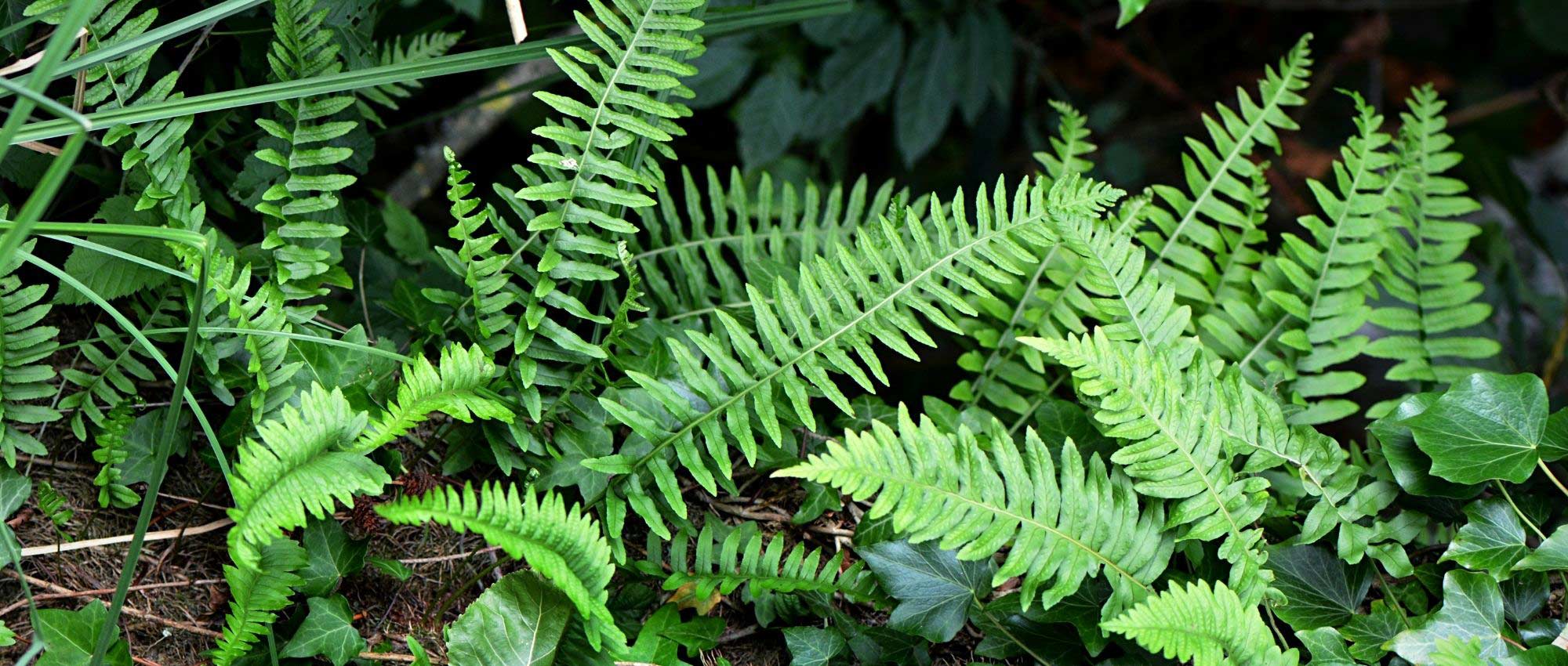
Polypodium: planting, growing, and care
Contents
Polypody in a nutshell
- Polypody is a lovely little fern with dark green fronds, once divided
- Its foliage is evergreen and decorative throughout the year
- It gradually spreads thanks to its running rootstock
- It is perfect in a natural woodland garden or in a cool, shaded rockery
- It grows easily on its own and requires almost no maintenance
A word from our Expert
Polypody is a lovely fern with bright green, evergreen fronds, divided into long pinnae. It has a running rhizome, allowing it to spread gradually. The most common is the Polypodium vulgare, a plant found in the wild in France, in forests. It can grow on the ground, as an epiphyte on tree trunks, or on walls. It is a small plant, typically measuring 20 to 30 cm in height. It thrives in cool, fertile soil and is very hardy. There is also an original variety, Polypodium vulgare ‘Bifido Multifidum’, which is characterised by the tips of its pinnae being divided into several lobes.
Polypody is a small fern that is very easy to grow. Once established, it requires little maintenance, apart from occasional watering during dry spells and the pruning of dry or damaged fronds. It is ideal in a woodland garden, alongside other ferns and shade plants, but also fits well in a shaded rockery or on a wall. It needs very little substrate. It can be easily propagated by division of the rhizome.
Botany
Botanical data
- Latin name Polypodium sp.
- Family Polypodiaceae
- Common name Polypody, Licorice Fern
- Flowering none
- Height often between 20 and 30 cm, up to 50 cm at maximum
- Exposure shade or partial shade, non-burning sun
- Soil type cool, fertile, shallow
- Hardiness between -20 and -30 °C
The Polypody is a small evergreen fern with running rhizomes. There are over 160 species of polypodies, most of which are tropical and epiphytic plants. However, this sheet will focus on temperate species that can be easily cultivated in gardens. They can grow in soil or as epiphytes on tree trunks, and even directly on stone walls. In France, a few species can be found in the wild, notably Polypodium vulgare. It primarily grows in forests (but sometimes in open areas), on rocks, walls, as an epiphyte on tree trunks, or directly in the soil. It is quite hardy and can be found up to 2,000 meters in altitude. Polypodium cambricum, on the other hand, is mainly found in the Mediterranean region.
The Polypody belongs to the large group of Pteridophyta, which includes ferns, horsetails, and clubmosses. These are primitive plants that existed long before the dinosaurs. They were among the first plants to emerge from water, alongside mosses, and remain dependent on water for reproduction. Among ferns, the Polypody belongs to the family Polypodiaceae, which has around 1,600 species.

Polypodium vulgare: Botanical illustration
Its Latin name comes from the Greek polus: many, and podion: little foot, referring to the rhizome that has many small roots. The species name vulgare means “common” in Latin. In French, it is nicknamed Licorice Fern because its rhizome has a taste of licorice!
The Polypody spreads through its running rhizome, but it does not become invasive! It also grows quite slowly. Its rhizome is fleshy and covered in scales, remaining shallow and very close to the soil surface. Additionally, it is edible: it has a licorice taste, both bitter and sweet! The Polypody typically measures 20 to 30 cm in height, reaching up to 50 cm at maximum.
The fronds develop along the rhizome, isolated from one another, and are connected to it by a petiole. They are dark green in colour and are once-divided. They are pinnate, divided into tightly packed, linear pinnules. The lamina is narrow and often tapers to a long point at the top (terminal pinnule). The fronds generally measure between 20 and 40 cm long. The fronds are coarsely cut, with the pinnules being less fine than those of most ferns.

The fronds of Polypodium vulgare and those of the variety ‘Bifido Multifidum’
The fronds of Polypodium vulgare persist in winter and renew in spring: new ones emerge as the old ones dry out. Its foliage remains decorative all year round! Polypodium cambricum, on the other hand, has the particularity of having an inverted growing season: its fronds appear in autumn, flourish in winter and spring, then dry out in early summer. The plant then enters dormancy until autumn, allowing it to avoid drought and high heat. It also has the advantage of tolerating drought more easily than most ferns.
Like other ferns, the Polypody does not produce flowers or seeds, but reproduces by producing spores. These are tiny organs that resemble dust and are enclosed in sacs called sporangia. In polypodies, the sporangia are grouped into sori (clusters of sporangia) that are round, about 2 mm in diameter. They are orange and are arranged in two regular rows on the underside of each pinnule. The sporangia appear in summer and are generally mature by August.
When they mature, the sporangia open and release the spores. These are dispersed by the wind and settle on the ground, where they will germinate in the presence of water. The spores then give rise to tiny intermediate organisms resembling moss or a fine green film, called prothalli. These carry the reproductive organs. The presence of water will allow fertilization, leading to the emergence of a small Polypody plant in the form we know.
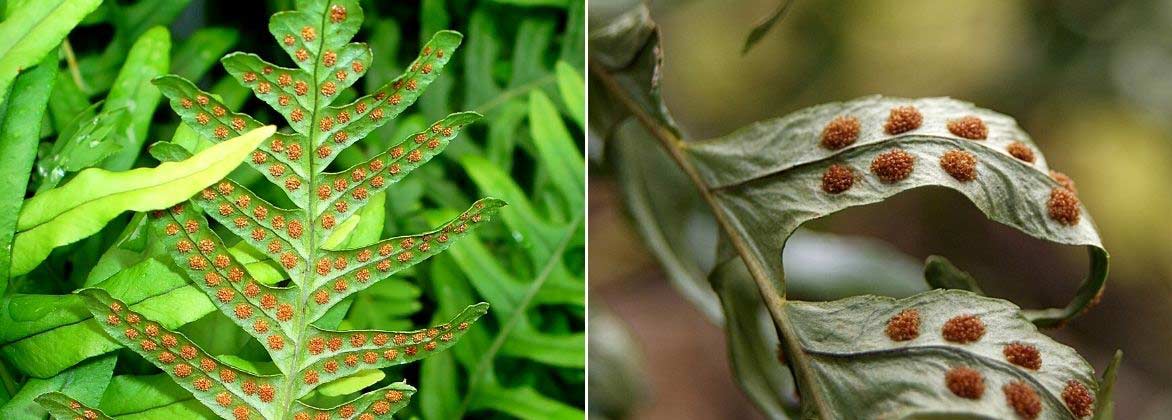
The fertile fronds of Polypodium vulgare, which bear the spores (photos: H. Zell / Danny S.)
Read also
Ferns: how to choose them?The main varieties
The most popular varieties
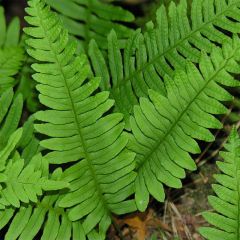
Polypodium vulgare - Rockcap Fern
- Height at maturity 25 cm
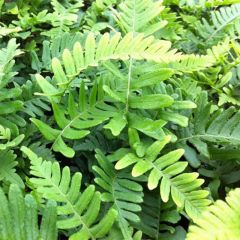
Polypodium vulgare Bifido Multifidum - Rockcap Fern
- Height at maturity 25 cm
Discover other Polypodium
View all →Available in 1 sizes

Available in 1 sizes
Available in 1 sizes
Available in 1 sizes
Available in 2 sizes
Available in 1 sizes
Planting
Where to plant?
As the polypody is a woodland plant, it thrives in shade or partial shade, and can also grow under non-scorching sunlight. It prefers soils similar to those found in forests: cool, fertile, and rich in humus. Don’t hesitate to add well-decomposed compost or leaf mould to enrich the soil. The polypody also enjoys well-drained ground, without excess moisture. It does not require much substrate: its rootstock is running and remains just below the soil surface, and its roots do not penetrate deeply. Polypody prefers acidic substrates but can also grow in calcareous soil.
Polypody brings a very natural effect to borders or woodland scenes! Plant it alongside other shade plants: hostas, Solomon’s seal, periwinkles, brunnera…
It will easily find its place in a cool, shaded rockery. You can also plant it in the crevices of a stone wall. Polypody requires very little substrate. As it sometimes grows epiphytically on tree trunks, you can easily install it on a dead tree stump! It can also be integrated into a green wall, cool and shaded.
When to plant?
The best times to plant polypody are autumn and spring. However, planting is possible all year round, avoiding periods of frost or extreme heat if possible.
How to plant?
In open ground:
- Place the root ball in a basin filled with water to rehydrate it.
- Dig a planting hole two to three times the volume of the root ball.
- Add well-decomposed compost to enrich the soil, and mix it with the earth.
- Plant your polypody.
- Replace the soil all around and firm it down.
- Water generously.
- Optionally, add a small layer of mulch.
Continue to water in the weeks following planting to keep the soil moist.
Our advice sheet: “Planting ferns: where, when, and how?”
On a stone wall:
- Find a gap between the stones on a wall that is large enough to insert substrate and the polypody’s rootstock.
- Mix garden soil with potting compost and place it in the gap of the wall.
- Plant the polypody.
- Fill in with soil and firm it down.
- Water. If water washes away some substrate, add more and firm it down again.
You can also plant Polypody in a pot.
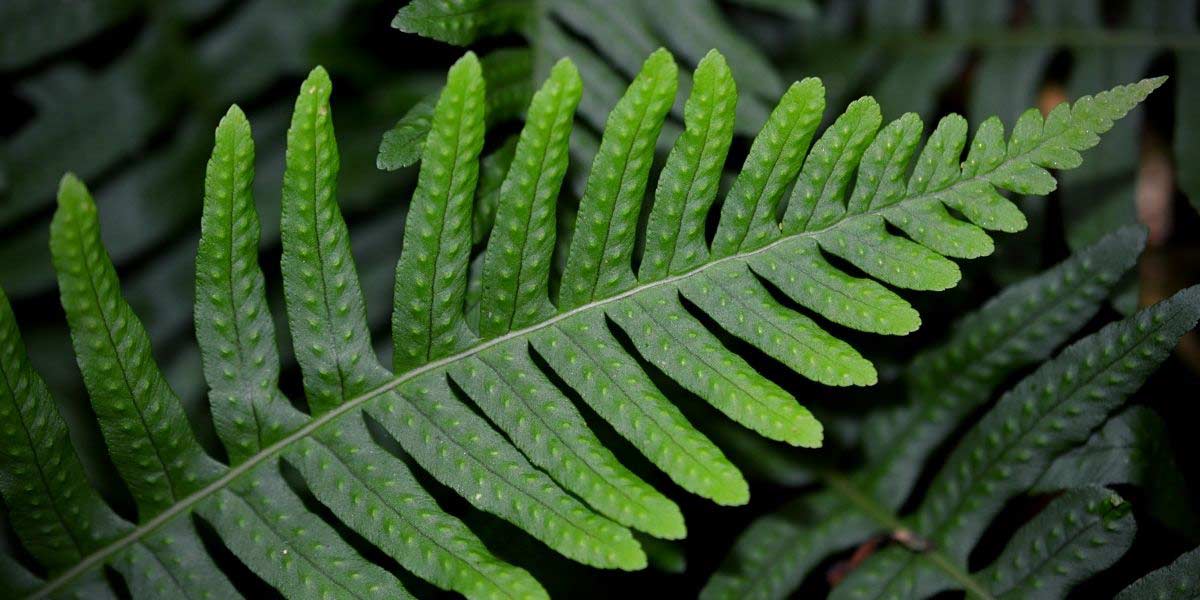
A frond of Polypodium x mantoniae, a hybrid between Polypodium vulgare and P. interjectum (photo: Ashley Basil)
Read also
How to sow fern spores?Care
The polypody is a very easy plant to grow, and it doesn’t really require much maintenance. However, we recommend watering in the weeks following planting, and then during dry spells. Watering should be a bit more frequent if you are growing the polypody in a pot, as the substrate dries out more quickly. However, avoid letting water stagnate in the bottom of the pot. You can also remove any dry or damaged leaves when you see them.
This is a very resilient plant, quite hardy, and it is not susceptible to diseases and pests. The polypody is a hassle-free plant!
Multiplication
The simplest and quickest technique for multiplying the polypody is division. Sowing spores requires time and specific conditions, but it allows for a greater number of young plants.
Sowing spores
Polypody sometimes self-seeds spontaneously, so you can simply collect the young plants. You can also harvest the spores to sow them. They appear on the underside of the fronds and detach on their own when they reach maturity, usually at the end of summer, around August.
- Harvest spores from Polypody;
- Take a transparent plastic container (such as a Tupperware) or a glass one;
- Mix potting soil and sand, and sieve it;
- Place it in the container, water to moisten it, then microwave for about 10 minutes to sterilise it;
- Wait for it to cool, then evenly scatter the spores on the surface. Do not cover them!
- Cover the container with plastic wrap or a transparent lid to create a sterile and humid atmosphere;
- Then place your sowing in a bright location, out of direct sunlight, at a temperature of around 15 °C.
After that, all you have to do is wait. The development of new ferns takes time, as the prothallus must first appear to allow for fertilisation. You can also water with a spray bottle if you notice that the substrate is drying out.
For more tips, check out our sheet “How to Sow Fern Spores?”
Division of clumps
It is very easy to multiply Polypody by dividing the rootstock. We recommend doing this in spring, in May or June.
- Dig up a well-developed and spreading polypody;
- Clear the excess soil around the rootstock;
- Cut it into several sections using a sharp knife, ensuring that each has roots and a few fronds;
- Replant the sections of rootstock immediately, and water.
Pairing ideas
For a very natural scene, we recommend pairing the polypody with other woodland perennials. You might choose hostas, periwinkles, Solomon’s seal, Anemone nemorosa, Geranium nodosum, astrantias, lady’s mantle… Also consider helxine and Lysimachia nummularia, whose foliage will beautifully cover the soil. You can also integrate other ferns, such as Athyrium niponicum, hart’s-tongue ferns, or Blechnum spicant, and grasses like Hakonechloa macra. When combined with other perennials, the polypody contributes to a lush and wild appearance in a woodland setting!
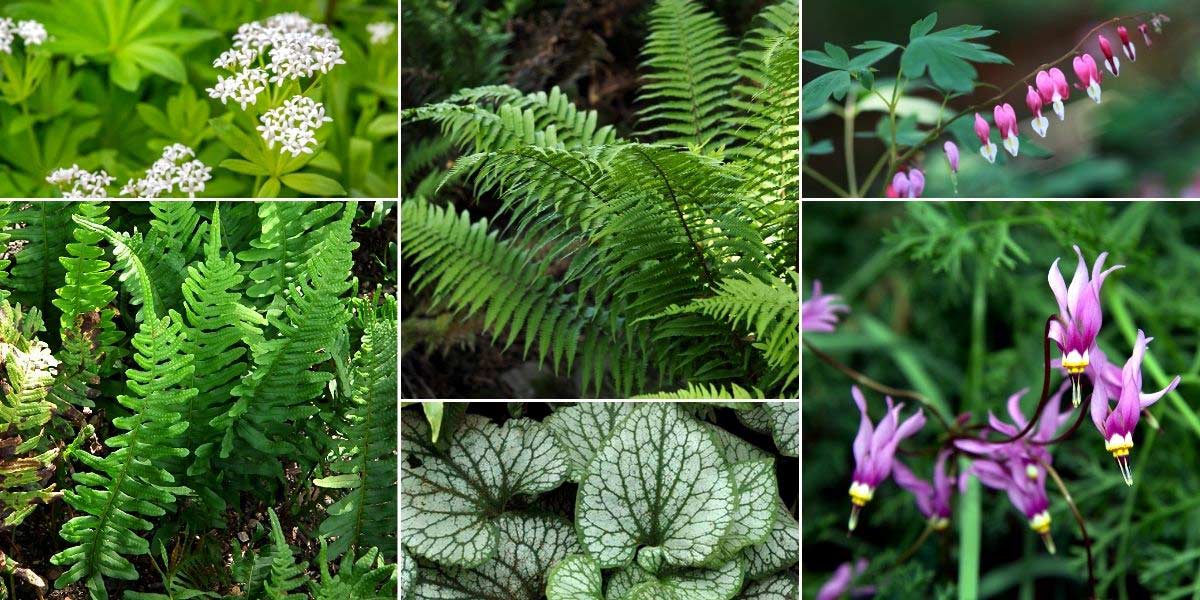
Integrate polypody into a naturally styled woodland garden! Sweet woodruff, Dryopteris wallichiana, Dicentra spectabilis, Polypodium vulgare (photo 4028mdk09), Brunnera ‘Jack Frost’ and Dodecatheon conjugens (photo C.T. Johansson)
As it often grows between stones or in rocky slopes in nature, you can certainly plant polypody in a cool, shaded rockery. Pair it with hart’s-tongue ferns, Asplenium trichomanes, Ajuga reptans, Epimedium, saxifrages… For more ideas, feel free to check our sheet “10 plants to create a shady rockery”.
Finally, polypody will also find its place in a graphic and Japanese-style garden, alongside helxines, hostas, Japanese maples, horsetails, bamboos, Athyrium niponicum…
If you would like more ideas and inspiration for pairing polypody, discover our sheet “Ferns: 9 easy association ideas to succeed”.
Useful resources
- The Polypodium vulgare
- The Polypodium vulgare ‘Bifido Multifidum’
- Discover our entire range of ferns!
- Our complete guide “Ferns: planting and growing”
- Subscribe!
- Contents































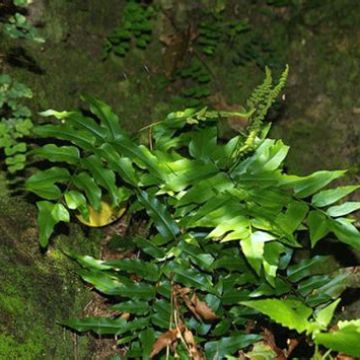

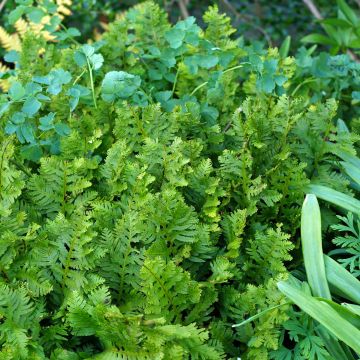

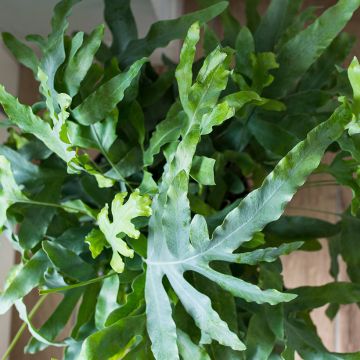
Comments